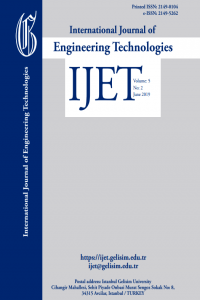Fractional Distillation & Characterization of Tire Derived Pyrolysis Oil
Energy is extracted recently from the waste products. Environmental pollution is being minimized along with the addition of considerable amount of energy beside the conventional sources. The energy extracted from the waste leads a hope of alternative fuel for internal combustion engines as well as to meet other requirement. Common energy conversion method uses tire, wood, rubber to derived energy through pyrolysis. About 9.25% gaseous, 43% liquid and 47% solid product are obtained for tire pyrolysis process at around 450 °C temperature. The liquid fuel is directly used in the engines and there phase is a mixture of complex hydrocarbon. In this work Fractional Distillation, oxidative desulfurization and de-colorization for upgrading liquid product has been conducted. In fractional distillation 30%, 20%, 6.35%, 6%, 4.5% and 1.3% by volume oils are obtained at over the temperature ranges- 121-180 oC, 211-260 oC, 71-120 oC, 191-210 oC, 181-190 oC and 40-70 oC. Then by desulfurization around 54-58 % sulfur was removed. For desulfurization hydrogen peroxide and formic acid (2:1 ratio) are used at constant temperature and magnetic stirring rate. The obtained fraction were characterized by elemental analyses, FT-IR techniques and compared with conventional diesel fuel. Sludge oil parts may be used as furnace oil which has higher calorific value than that of other conventional furnace oils. The rest of 40-70 oC and 71-120 oC oil parts may be used as alternative fuel like kerosene. Thus, the aim of the present study is to investigate the suitability of pyrolysis oil as an alternative fuel for IC engine.
___
- Scrap tire markets in the United States, 9th Biennial Report, Rubber Manufacturers Association, May 2009.
- Rubber Manufacturers Association (RMA), Scrap Tire Markets in the United States; 2005.
- A. M. Mastral, R. Murillo , M. S. Callen, and T. Garcia, “Optimisation of scrap automotive tyres recycling into valuable liquid fuels”, Resources, Conservation and Recycling, Vol. 29, Issue 4, pp. 263–272, June 2000.
- A. M. Cunliffe, and P. T. Williams, “Composition of oils derived from the batch pyrolysis of tyres”, Journal of Analytical and Applied Pyrolysis, Vol. 44, Issue 2, pp. 131–152, January 1998.
- P. T. Williams, and A. J. Brindle, “Temperature selective condensation of tyre pyrolysisoils to maximise the recovery of single ring aromatic compounds”, Fuel, Vol. 82, Issue 9, pp. 1023–1031, June 2003.
- S. Ucar, S. Karagoz, A. R. Ozkan, and J. Yanik, “Evaluation of two different scrap tires ash hydrocarbon source by pyrolysis”, Fuel, Vol. 84, Issues 14–15, pp. 1884–1892, October 2005.
- C. Berrueco, E. Esperanza, F. J. Mastral, J. Ceamanos, and P. Garcı ́a-Bacaicoa, “Pyrolysis of waste tyres in a atmospheric static-bed batch reactor”, Journal of Analytical and Applied Pyrolysis, Vol. 74, Issues 1–2, pp. 245–253, August 2005.
- Isabel de Marco Rodriguez, M. F. Laresgoiti, M. A. Cabrero, A Torres, M. J. Chomón, and B. Caballero, “Pyrolysis of scrap tyres”, Fuel Processing Technology, Vol. 72, Issue 1, pp. 9–22, August 2001.
- M. R. Islam, M. N. Islam, N. N. Mustafi, M. A. Rahim, and H. Haniu, “Thermal recycling of solid tire wastes for alternative liquid fuel: the first commercial step in Bangladesh”, Procedia Engineering Vol. 56, pp. 573-582, 2013.
- S. Murugan, M. C. Ramaswamy, and G. Nagarajan, A comparative study on the performance, emission and combustion studies of a DI diesel engine using distilled tire pyrolysis oil–diesel blends, Fuel, Vol. 87, Issues 10–11, pp. 2111–2121, August 2008.
- S. Murugan, M. C. Ramaswamy, and G. Nagarajan, The use of tire pyrolysis oil in diesel engines, Waste Management, Vol. 28, Issue 12, pp. 2743–2749, December 2008.
- J. L. Humphrey, and G. E. Keller, Separation Process Technology, New York: McGraw-Hill, 1997, ch. 1.
- K. Kolmetz, W. K. Ng, S. H. Lee, T. Y. Lim, D. R. Summers, and C. A. Soyza, “Optimize distillation column design for improved reliability in operation and maintenance”, 2nd Best Practices in Process Plant Management, Kuala Lumpur, Malaysia, March 14-15, 2005.
- Distillation Column Selection and Sizing. KLM Technology group, Available at: www.klmtechgroup.com, 2011.
- R. K. Sinnott, Coulson & Richardson’s Chemical Engineering, 4th ed., Vol. 6. Elsevier, 2006, pp. 564- 565.
- H. Z. Kister, Distillation design. New York: McGraw-Hill Book Co., 1992, ch. 3.
- Uses and Benefits of Glass Wool, https://storify.com/VarunSharma123/uses-and benefits- of-glass-wool, 2016.
- How an FTIR Spectrometer Operates. Available at:http://chemwiki.ucdavis.edu/Core/Physical_Chemistr y/Spectroscopy/Vibrational_Spectroscopy/Infrared_Spe ctroscopy/How_an_FTIR_Spectrometer_Operates, 2016.
- ISSN: 2149-0104
- Başlangıç: 2015
- Yayıncı: İstanbul Gelişim Üniversitesi
